- The Complete Guide to Pruning Fruit Trees in Winter and Spring
- 1. Tools
- 2. Timing
- 3. Goals of Pruning
- 4. Pruning Techniques
- 5. Special Considerations
- Conclusion
- Importance of Pruning for Fruit Tree Health
- 1. Enhances Sunlight Penetration
- 2. Prevents Disease and Pest Infestations
- 3. Promotes Air Circulation
- 4. Controls Tree Size and Shape
- 5. Stimulates New Growth and Fruit Production
- When to Prune Fruit Trees in Winter and Spring
- Pruning in Winter
- Pruning in Spring
- General Pruning Guidelines
- Tools and Equipment for Pruning Fruit Trees
- Common Pruning Techniques for Fruit Trees
- 1. Thinning
- 2. Heading Back
- 3. Training
- 4. Renewal Pruning
- 5. Espalier Pruning
- Avoiding Common Pruning Mistakes
- 1. Overpruning
- 2. Pruning at the wrong time
- 3. Using blunt or dull tools
- 4. Neglecting to sanitize tools
- 5. Ignoring the tree’s natural shape
- 6. Removing too many fruiting branches
- 7. Failing to make proper cuts
- How to Prune Different Types of Fruit Trees
- 1. Apple Trees
- 2. Pear Trees
- 3. Peach Trees
- 4. Cherry Trees
- 5. Plum Trees
- Pruning Fruit Trees for Optimal Fruit Production
- 1. Prune during the dormant season
- 2. Remove dead or diseased branches
- 3. Thin out crowded branches
- 4. Shape the tree
- 5. Consider the age of the tree
- 6. Use proper pruning tools
- 7. Evaluate the tree’s response
- Expert Tips for Pruning Fruit Trees
- 1. Timing is Key
- 2. Remove Dead and Diseased Wood
- 3. Thin Out Overcrowded Branches
- 4. Create an Open Center
- 5. Prune for Fruit Production
- 6. Know Your Fruit Tree Species
- Conclusion
- Question-answer:
- When is the best time to prune fruit trees?
- What tools do I need for pruning fruit trees?
- How much should I prune off my fruit tree?
- Can I prune my fruit tree if it’s already blooming?
- How do I know which branches to prune?
- Should I prune my young fruit tree differently than a mature one?
- Do I need to apply any treatments or sealants to the cuts after pruning?
- Video: You’re (Probably) Killing Your Fruit Trees
Pruning fruit trees is an essential task for any gardener or arborist. Not only does it help to maintain the health and shape of the tree, but it also promotes better fruit production and overall growth. However, understanding when and how to prune fruit trees can be a daunting task for beginners. That’s why we’ve put together this comprehensive guide to help you master the art of pruning fruit trees in winter and spring.
Winter and spring are the ideal seasons for pruning fruit trees. During this time, the trees are dormant, which means they are less likely to experience stress or damage from pruning. Additionally, pruning during these seasons helps to stimulate new growth and ensure that the tree is ready for a bountiful fruit harvest in the upcoming season.
When it comes to pruning fruit trees, it’s important to follow the proper techniques. This includes removing any dead, diseased, or damaged branches, as well as thinning out crowded areas to improve air circulation and sunlight penetration. It’s also crucial to make clean cuts at the right angle and avoid cutting too close or leaving stubs, which can lead to disease and insect infestation.
Expert tips and advice can make all the difference when it comes to pruning fruit trees. In this guide, we’ll cover everything from the best tools and equipment to use, to specific techniques for different types of fruit trees, such as apple, pear, and cherry trees. Whether you’re a beginner or an experienced gardener, this guide will give you the knowledge and confidence to effectively prune your fruit trees and ensure a healthy and abundant harvest.
The Complete Guide to Pruning Fruit Trees in Winter and Spring
Pruning fruit trees is an essential practice for maintaining the health, productivity, and appearance of your trees. Proper pruning techniques can help shape the tree, control its size, improve airflow and sunlight penetration, and promote the growth of new fruit-bearing wood. This guide will provide you with expert tips and techniques for pruning your fruit trees during the winter and spring months.
1. Tools
Before you start pruning, make sure you have the right tools on hand. These may include:
- Pruning shears or secateurs
- Loppers
- Pole pruner
- Saw
- Gloves
Having the right tools will make the pruning process easier and more efficient.
2. Timing
In general, fruit trees should be pruned during their dormant period, which is usually in late winter or early spring before the buds start to swell. Pruning during this time allows the tree to heal wounds more effectively and reduces the risk of pest and disease infestations. However, it’s important to check the specific recommendations for the type of fruit tree you have, as some may have different pruning requirements.
3. Goals of Pruning
When pruning fruit trees, you should have several goals in mind:
- To remove dead, diseased, or damaged wood
- To thin out overcrowded branches to improve airflow and sunlight penetration
- To shape the tree and control its size
- To encourage the growth of new fruit-bearing wood
Keeping these goals in mind will help you make informed decisions about which branches to prune and how much to remove.
4. Pruning Techniques
When pruning fruit trees, it’s important to use proper techniques to ensure the best results:
- Start by removing any dead, diseased, or damaged wood. Cut at a 45-degree angle just outside the branch collar to promote healing.
- Thinning out overcrowded branches can be done by selectively removing entire branches or cutting them back to a lateral branch. This will improve airflow and sunlight penetration, reducing the risk of diseases.
- To shape the tree and control its size, prune branches that are growing in undesirable directions or crossing over each other. Cut back to a lateral branch or the main trunk.
- To encourage the growth of new fruit-bearing wood, selectively prune branches that are older and less productive. This will stimulate the growth of new shoots and increase fruit production.
5. Special Considerations
Some fruit trees may have specific pruning requirements or considerations. For example, apple trees may benefit from a central leader or modified central leader pruning method, while peach trees may require more aggressive pruning to maintain productivity. It’s important to research and understand the specific needs of your fruit tree before pruning.
Conclusion
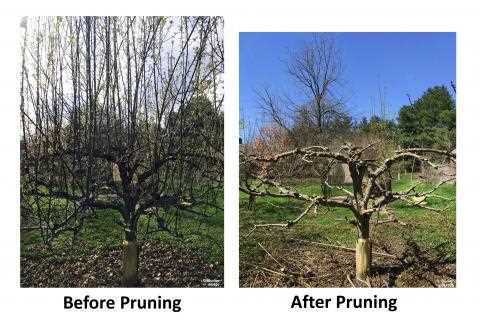
Pruning your fruit trees during winter and spring is a vital practice for maintaining their health and productivity. By using the right tools, pruning at the correct time, and following proper techniques, you can shape your trees, control their size, improve airflow and sunlight penetration, and promote new fruit-bearing wood. Keep in mind the specific goals of pruning and any special considerations for your fruit tree type, and you’ll be on your way to healthy and bountiful harvests.
Importance of Pruning for Fruit Tree Health
Pruning is an essential practice for maintaining the health and productivity of fruit trees. When done correctly, pruning helps to shape the tree, improve air circulation, and promote the development of strong, fruit-bearing branches. Here are some key reasons why pruning is important for the health of fruit trees:
1. Enhances Sunlight Penetration
Pruning allows for better sunlight penetration by removing excessive foliage and thinning out branches. Sunlight is crucial for the process of photosynthesis, where trees convert sunlight into energy. Improved sunlight exposure promotes the production of sugars, which are essential for fruit development, color, and flavor.
2. Prevents Disease and Pest Infestations
Pruning helps to prevent the spread of diseases and pest infestations by removing dead, damaged, or diseased branches. These branches can serve as entry points for pathogens and pests, which can harm the overall health of the tree and reduce fruit production. By removing these branches, you can minimize the risk of infections and infestations.
3. Promotes Air Circulation
Proper pruning creates open spaces within the canopy of the tree, allowing for improved air circulation. Good air circulation helps to reduce the chances of fungal diseases, as it prevents the build-up of moisture, which can lead to fungal infections. Additionally, improved air circulation also helps to strengthen the tree by preventing the development of weak, spindly branches.
4. Controls Tree Size and Shape
Pruning allows you to control the size and shape of the tree, making it easier to manage and harvest fruit. By regularly pruning, you can prevent the tree from getting too tall, which can make it difficult to reach the fruit. Pruning also helps to maintain a balanced structure, ensuring that the weight of the fruit is evenly distributed across the tree.
5. Stimulates New Growth and Fruit Production
Pruning stimulates the growth of new branches and buds, which are essential for fruit production. By removing older, less productive branches, you create space for new growth and encourage the tree to focus its energy on producing fruit. Pruning also helps to improve the quality and size of the fruit by allowing the tree to channel nutrients to fewer branches.
In conclusion, pruning plays a crucial role in maintaining the health and productivity of fruit trees. By enhancing sunlight penetration, preventing diseases and pests, promoting air circulation, controlling tree size and shape, and stimulating new growth, pruning helps to ensure that fruit trees produce high-quality fruit and remain in optimal condition.
When to Prune Fruit Trees in Winter and Spring
Proper timing is crucial when it comes to pruning fruit trees in winter and spring. The goal is to prune when the trees are dormant, but before new growth begins in the spring. This ensures that the tree has enough time to heal before it starts actively growing again.
Pruning in Winter
Winter is generally the ideal time to prune fruit trees. It is important to wait until the coldest part of winter has passed, as pruning during extremely cold temperatures can damage the tree. In most regions, late winter or early spring is the best time to prune. This timing allows you to assess any winter damage and remove any dead, diseased, or damaged branches.
Pruning in Spring
If you missed the window to prune in winter, you can still prune fruit trees in early spring before buds break open. However, it is essential to avoid pruning too late in the spring when new growth is already starting. Late pruning can stimulate excessive new growth that the tree may struggle to support.
It is important to note that the specific timing for pruning fruit trees can vary depending on the climate and the particular fruit tree variety. It is always a good idea to consult local agricultural extension services or a professional arborist for specific guidance.
General Pruning Guidelines
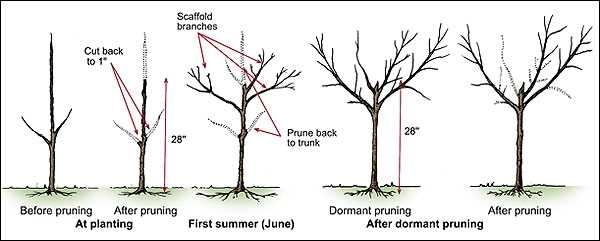
When pruning fruit trees, keep the following guidelines in mind:
- Start by removing any dead, diseased, or damaged branches.
- Thin out overcrowded branches to improve sunlight penetration and airflow.
- Avoid pruning too aggressively, as this can harm the tree’s overall health and productivity.
- Use sharp, clean pruning tools to make clean cuts and minimize the risk of disease transmission.
- Consider the tree’s shape and structure when making pruning cuts, aiming for an open, balanced canopy.
By following these guidelines and pruning at the right time, you can help promote the health, productivity, and aesthetic appeal of your fruit trees.
Tools and Equipment for Pruning Fruit Trees
Pruning fruit trees is an essential task for maintaining their health and productivity. To do the job effectively, you’ll need a few essential tools and equipment. Here are some of the necessary items:
- Pruning shears: Also known as hand-held pruners, pruning shears are essential for cutting small branches and twigs. Look for a pair with a sharp blade and a comfortable grip.
- Pruning saw: A pruning saw is necessary for cutting larger branches. Choose a saw with a curved blade and sharp teeth for easier cutting.
- Loppers: Loppers are long-handled pruners with a thicker cutting blade. They are useful for cutting branches that are too thick for pruning shears but smaller than what a pruning saw can handle.
- Pole pruner: A pole pruner is a long pole with a pruning shear or saw on the end. It allows you to reach high branches without using a ladder.
- Gloves: A good pair of gardening gloves will protect your hands from cuts and scratches while pruning.
- Safety goggles: When pruning, there is a risk of debris flying into your eyes. Wear safety goggles to protect your eyes from any potential harm.
- Ladder: Depending on the size of your fruit trees, you may need a ladder to reach higher branches. Choose a sturdy ladder that can support your weight.
- Pruning sealant: Pruning sealant is a protective coating that can be applied to the cut ends of branches to prevent disease and pests from entering.
Having the right tools and equipment will make your pruning tasks easier and more efficient. Make sure to choose high-quality tools that are comfortable to use and maintain them properly to ensure their longevity.
Common Pruning Techniques for Fruit Trees
Pruning is an essential task for maintaining the health and productivity of fruit trees. By carefully removing branches and shaping the tree, pruning helps to stimulate new growth, improve air circulation, and increase fruit production. There are several common pruning techniques that are used for fruit trees:
1. Thinning
- Thinning involves selectively removing stems and branches to reduce density and allow for better light penetration.
- Start by removing any dead, damaged, or diseased branches.
- Next, prune out any branches that are crossing or rubbing against each other.
- Thin out branches that are growing vertically or too close together, as this can create a crowded canopy.
- By thinning the tree, you can improve airflow and reduce the risk of disease.
2. Heading Back
- Heading back is a technique used to control the height and shape of the tree.
- Prune back the main central stem to encourage lateral branching and create a more compact tree.
- Heading back can help to maintain a manageable size for easier harvesting and maintenance.
3. Training
- Training involves shaping young trees to develop a strong structure and desired form.
- Remove any competing or crossing branches to create a well-spaced scaffold of branches.
- Encourage a central leader by pruning competing leaders or branches that are growing too upright.
- Train lateral branches to grow at wide angles to prevent overcrowding and improve light exposure.
4. Renewal Pruning
- Renewal pruning is used to rejuvenate older fruit trees that have become overgrown or unproductive.
- Remove older, unproductive wood by cutting it back to a younger, more vigorous branch or bud.
- Renewal pruning stimulates new growth and helps to restore fruiting capacity.
5. Espalier Pruning
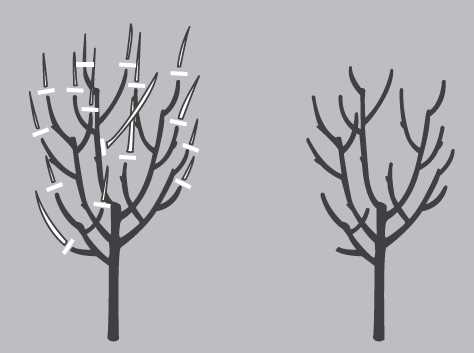
- Espalier pruning is a technique used to train fruit trees to grow flat against a wall or support structure.
- Prune branches to create a two-dimensional, horizontal framework of branches.
- Regularly prune and train new growth to maintain the espalier form.
- Espalier pruning is ideal for small spaces and can maximize fruit production.
By employing these common pruning techniques, you can help your fruit trees thrive and produce an abundant harvest. Remember to use sharp, clean tools and make smooth, angled cuts to promote healing and minimize damage. Happy pruning!
Avoiding Common Pruning Mistakes
When it comes to pruning fruit trees, it’s important to avoid common mistakes that can hinder the growth and health of your trees. Here are some tips to help you avoid these pitfalls and ensure successful pruning:
1. Overpruning
One common mistake is overpruning, which involves removing too much of the tree’s canopy. This can weaken the tree and stunt its growth. It’s important to maintain a balance between removing enough branches to promote airflow and sunlight penetration, while still leaving enough foliage to support the tree’s overall health.
2. Pruning at the wrong time
Timing is crucial when pruning fruit trees. Pruning during the wrong season can lead to excessive bleeding, reduce fruit production, and increase the risk of disease or pest infestation. It’s generally recommended to prune fruit trees during the dormant period, which is typically in late winter or early spring before new growth begins.
3. Using blunt or dull tools
Using dull or blunt pruning tools can result in ragged cuts, which can make it more difficult for the tree to heal and increase the risk of disease entry. It’s important to regularly sharpen your pruning tools to ensure clean and smooth cuts. This will help promote faster healing and reduce the risk of complications.
4. Neglecting to sanitize tools
Pruning tools can spread diseases from one tree to another if not properly sanitized between cuts. It’s important to sanitize your tools between pruning different trees or branches to prevent the transmission of diseases. You can use a solution of bleach and water or rubbing alcohol to clean and disinfect your tools.
5. Ignoring the tree’s natural shape
Each fruit tree has a natural growth pattern and shape. Pruning should be done to enhance the tree’s natural form rather than trying to force it into a particular shape. Ignoring the tree’s natural shape can lead to imbalanced growth, reduced fruit production, and increased susceptibility to disease or pest damage.
6. Removing too many fruiting branches
While it’s important to remove some branches to maintain the tree’s health and shape, removing too many fruiting branches can significantly reduce the tree’s fruit production. It’s important to strategically choose which branches to prune to ensure a good balance between new growth and fruiting branches.
7. Failing to make proper cuts
Improper cuts can damage the tree and slow down the healing process. When making cuts, it’s important to use proper pruning techniques, such as making clean cuts at the correct angle just outside the branch collar. This will promote faster healing and reduce the risk of complications.
To sum up, by avoiding these common pruning mistakes, you can help maintain the health and productivity of your fruit trees. Remember to strike a balance between removing enough branches for airflow and sunlight while leaving enough foliage for overall tree health. Happy pruning!
How to Prune Different Types of Fruit Trees
1. Apple Trees
Apple trees require annual pruning to maintain their shape and improve fruit production. Start by removing any dead, diseased, or crossing branches. Open up the center of the tree to promote better airflow and sunlight penetration. Cut back any vigorous branches to maintain a balanced structure.
2. Pear Trees
Similar to apple trees, pear trees also benefit from annual pruning. Remove any branches that are growing vertically, as they can create a dense canopy that limits sunlight and air circulation. Thin out any crowded areas to improve fruit quality and prevent disease. Prune in the late winter or early spring before new growth begins.
3. Peach Trees
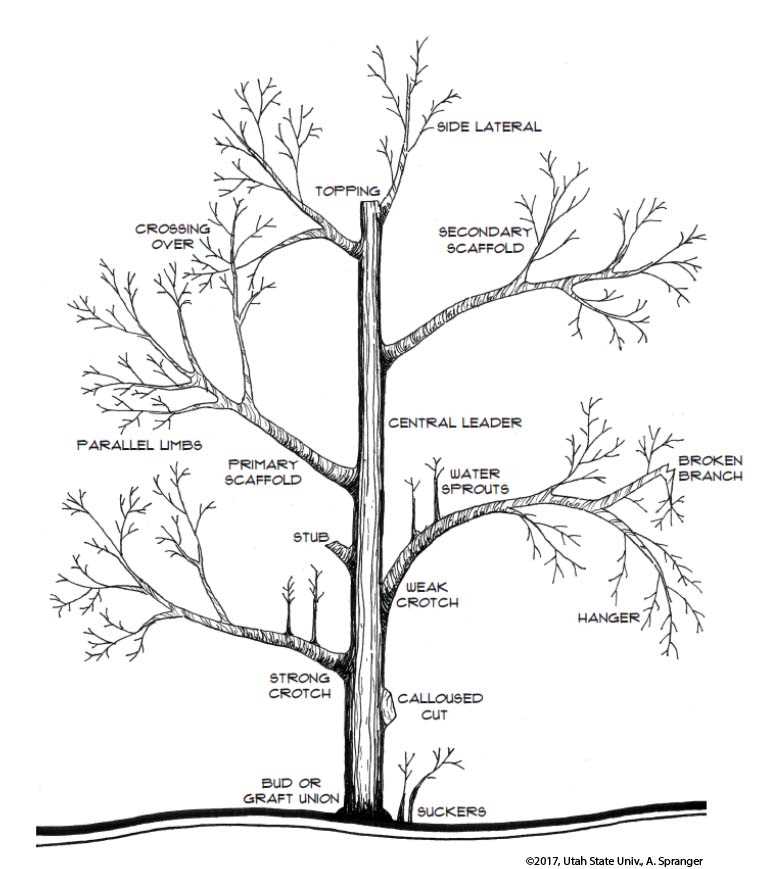
Peach trees have a more open growth habit compared to apple and pear trees. Thin out the center of the tree to allow sunlight to reach the fruiting wood. Remove any dead or damaged branches. Peach trees produce fruit on one-year-old wood, so avoid removing too much of this growth during pruning.
4. Cherry Trees
Cherry trees require minimal pruning, but it’s still important to remove dead or diseased branches. Prune in the summer after harvest to avoid the risk of the silver leaf disease. Remove any suckers or water sprouts growing from the base of the tree. Maintain an open center to improve air circulation and sunlight exposure.
5. Plum Trees
To prune plum trees, remove any dead, diseased, or crossing branches. Thin out the canopy to allow sunlight to reach the inner branches. Prune in the late winter or early spring before new growth begins. Avoid excessive pruning, as plum trees tend to produce fruit on spurs that form on older wood.
When pruning fruit trees, always use sharp and clean pruning tools to make clean cuts. Avoid pruning during periods of extreme cold or wet weather, as this can stress the tree. Regular pruning will help keep your fruit trees healthy and productive for years to come.
Pruning Fruit Trees for Optimal Fruit Production
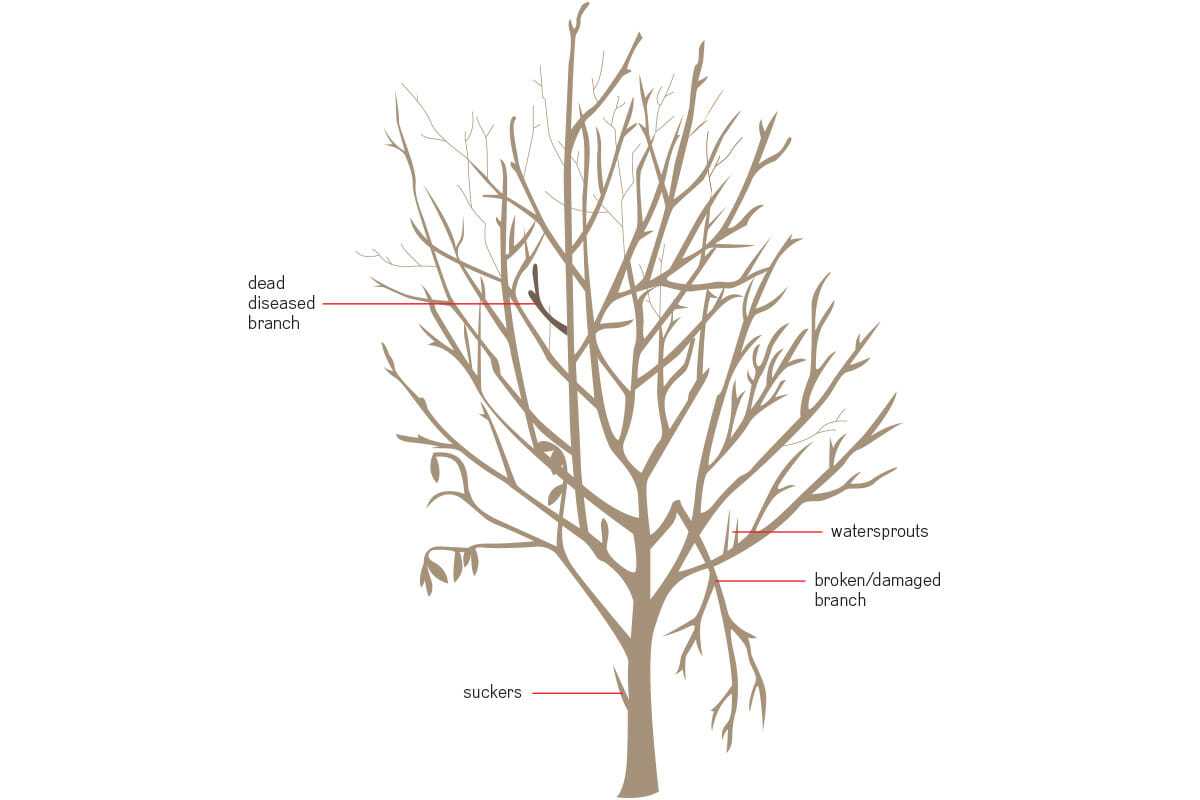
Pruning fruit trees is an essential practice for ensuring optimal fruit production. By carefully shaping and trimming the branches, you can encourage the tree to produce more fruit, improve its health, and maintain a manageable size. Here are some expert tips and techniques for pruning fruit trees:
1. Prune during the dormant season
The best time to prune fruit trees is during the dormant season, which is typically in winter or early spring before the new growth starts. Pruning during this time allows the tree to heal quickly and minimizes the risk of disease or pest infestation. Avoid pruning during the flowering or fruiting season, as it may reduce the crop yield.
2. Remove dead or diseased branches
Start by inspecting the tree for any dead or diseased branches. Dead branches not only look unsightly but can also harbor pests and diseases. Prune them back to the trunk or the nearest healthy branch. Diseased branches should also be removed to prevent the spread of infection.
3. Thin out crowded branches
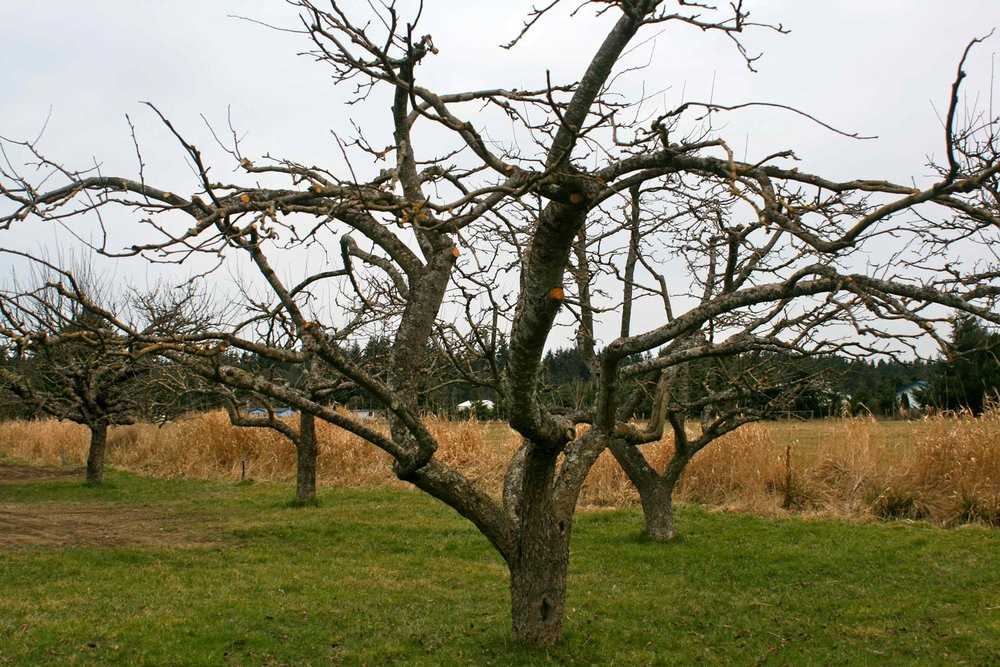
Thin out any crowded branches to improve air circulation and sunlight penetration. This will help prevent the development of diseases and allow the fruit to ripen evenly. Selectively remove some of the smaller or weaker branches, focusing on opening up the center of the tree to let light in.
4. Shape the tree
Prune the tree to shape it and maintain a balanced structure. Start by removing any branches that cross or rub against each other, as they can damage the bark and create entry points for pests and diseases. Aim for an open center or a modified central leader shape, depending on the type of fruit tree.
5. Consider the age of the tree
The age of the tree can also influence how it should be pruned. Young fruit trees require pruning to establish a strong framework, while older trees may need more maintenance pruning to remove dead or unproductive branches. Adjust your pruning techniques accordingly based on the age of the tree.
6. Use proper pruning tools
Make sure you use sharp and clean pruning tools to make clean cuts and minimize the risk of introducing infection. Pruning shears, loppers, and pruning saws are commonly used for pruning fruit trees. Disinfect your tools between cuts, especially if you are pruning multiple trees to prevent the spread of diseases.
7. Evaluate the tree’s response
Observe how the tree responds to pruning and adjust your techniques in subsequent years. Pay attention to the growth pattern, fruiting habits, and overall health of the tree. Sometimes, it may take a few seasons before you achieve the desired results, so be patient and continue to refine your pruning skills.
Pruning fruit trees can be a rewarding and satisfying task that leads to healthier trees and abundant fruit production. By following these expert tips and techniques, you can maximize the productivity of your fruit trees and enjoy a bountiful harvest year after year.
Expert Tips for Pruning Fruit Trees
Pruning your fruit trees is an essential task to ensure healthy growth and bountiful fruit production. Here are some expert tips to help you get the most out of your pruning efforts:
1. Timing is Key
- Prune your fruit trees in late winter or early spring, before they start to actively grow.
- Avoid pruning during extremely cold weather, as this can damage the tree.
2. Remove Dead and Diseased Wood
- Inspect your fruit tree for any dead or diseased branches.
- Use sharp, clean tools to remove these branches, cutting them back to healthy wood.
- Dispose of the pruned wood properly to prevent the spread of diseases.
3. Thin Out Overcrowded Branches
- Identify branches that are crossing or rubbing against each other.
- Selectively prune these branches to improve air circulation and reduce the risk of disease.
- Remove any branches that are growing straight up or down.
4. Create an Open Center
- For most fruit trees, aim to create an open center shape.
- This involves removing the central leader and allowing multiple branches to grow outward.
- This shape allows sunlight to reach all parts of the tree and promotes even fruit ripening.
5. Prune for Fruit Production
- Consider the age of your fruit tree and its previous year’s growth.
- Remove any branches that are overcrowded or weak.
- Focus on retaining the branches that have the potential to produce the most fruit.
6. Know Your Fruit Tree Species
Apple Trees:
- Prune apple trees in late winter or early spring
- Remove any vertical water sprouts or branches that grow toward the center of the tree
- Maintain an open center shape
Peach Trees:
- Prune peach trees in early spring, just before bud break.
- Remove any branches that are less than one year old, as they will not produce fruit.
- Remove the oldest branches to promote new growth.
Cherry Trees:
- Prune cherry trees in late winter before bud break or in late summer after harvest.
- Remove any dead, diseased, or crossing branches.
- Thin out the center of the tree to improve airflow.
Conclusion
Pruning fruit trees can seem intimidating, but with the right knowledge and techniques, it becomes a rewarding task. Remember to always use sharp and clean tools, and to prune at the right time for optimal tree health and fruit production. Following these expert tips will help you achieve beautiful and productive fruit trees in your garden.
Question-answer:
When is the best time to prune fruit trees?
The best time to prune fruit trees is during the winter or early spring, before the buds start to break. This allows for proper healing and reduces the risk of disease.
What tools do I need for pruning fruit trees?
For pruning fruit trees, you will need a set of sharp pruning shears, loppers, a pruning saw, and possibly a pole pruner for taller trees. These tools will allow you to make clean and precise cuts.
How much should I prune off my fruit tree?
The amount you should prune off your fruit tree can vary depending on the size and health of the tree. Generally, you should aim to remove about 20-30% of the tree’s volume. This will help maintain its shape, promote new growth, and improve fruit production.
Can I prune my fruit tree if it’s already blooming?
It is not recommended to prune a fruit tree while it is blooming. Pruning at this time can disrupt the tree’s natural processes and reduce fruit production. It is best to wait until after the tree has finished blooming to do any pruning.
How do I know which branches to prune?
When pruning a fruit tree, you should look for branches that are dead, damaged, or diseased and remove them. Additionally, you can prune any branches that are crossing or rubbing against each other, as well as those that are growing inwards towards the center of the tree.
Should I prune my young fruit tree differently than a mature one?
Yes, you should prune a young fruit tree differently than a mature one. For young trees, the main goal is to establish a strong framework of branches. This involves selecting a central leader and a few well-spaced lateral branches. As the tree matures, you can focus more on thinning out overcrowded branches and maintaining its shape.
Do I need to apply any treatments or sealants to the cuts after pruning?
In most cases, it is not necessary to apply any treatments or sealants to the cuts after pruning. Fruit trees have the ability to heal themselves naturally. However, if you are pruning a tree that is susceptible to certain diseases, such as fire blight, it may be recommended to apply a thin layer of pruning paint or a similar product to help prevent infection.







